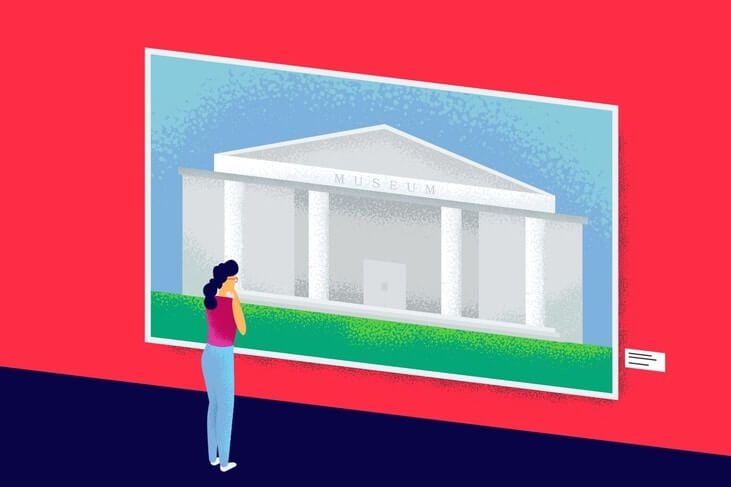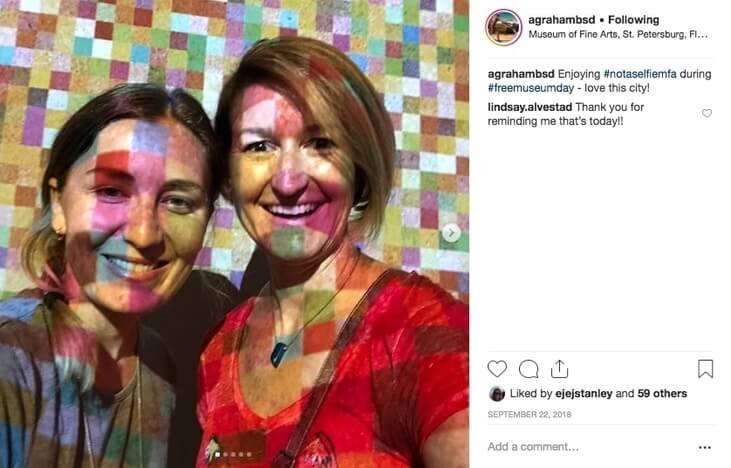10 Creative Museum Marketing Ideas to Attract More Visitors
- 1. Embrace smartphone culture
- 2. Encourage visitors to get social
- 3. Make your website as inviting as your exhibits
- 4. Turn your research into organic website visits
- 5. Host immersive events for more engagement
- 6. Use your (brand's) voice
- 7. Bring exhibits to the community
- 8. Leverage local influencers and publishers
- 9. Put some pennies into programmatic advertising
- 10. Cultivate community with a Facebook Group
- Museum Marketing FAQs
- Why do museums need marketing?
- What makes museum marketing different?
- How to think about museum marketing without losing sight of your mission and vision
- How do you market an art gallery?
- We're museum marketing experts
Museums are pillars of culture and learning: places where people can explore different traditions, cultivate new ideas, and encounter unique art forms.
They’re also constantly changing. Curators know this, but potential visitors often don’t. That means many museums miss out on attracting new and repeat visitors due to lack of engagement.
This blog explores 10 creative museum marketing ideas that will help you foster engagement, attract more visitors, and build a community around your institution.

1. Embrace smartphone culture
For years, museums fought against smartphones, encouraging visitors to put away their technology and focus on the images and artifacts in front of them. However, the top institutions across the world have embraced modern technology in their museum marketing, and are reaping the benefits because of it.
New York City’s Metropolitan Museum of Art has a mobile-focused website and app to guide visitors through its exhibits. People use their smartphones to learn more about the pieces they see and discover other works like them.
Sree Sreenivasan, the Met’s Chief Digital Officer, says the museum’s biggest competition isn’t the Guggenheim or the Museum of Modern Art, but rather Netflix, Candy Crush, and a desire to stay home rather than explore the city.
User-generated content is one of the most cost-effective ways you can boost your museum marketing.
2. Encourage visitors to get social
Another way museums like the Met increase attendance is by creating exhibits specifically for fans to promote on social media. Instead of denying visitors a chance to share what they saw with friends, museums can encourage people to snap selfies and share the museum content online. These photos promote museums as cool places to be and make online users wonder what the exhibits would look like in person. User-generated content is one of the most cost-effective ways you can boost your museum marketing.
The Museum of Fine Arts St. Petersburg recently hosted, “This is Not a Selfie,” an exhibition featuring photographic self-portraits from the Audrey and Sydney Irmas Collection at the Los Angeles County Museum of Art. Guests were encouraged to engage with an interactive portion of the exhibit and share their selfies on social media with the hashtag #notaselfieMFA.
Obviously, we had to check it out.
The Museum of Ice Cream in New York gained Instagram “cult status,” as people flocked to the exhibits to take photos with the various displays. Everyone wanted a photo in the sprinkle pool or on the ice cream sandwich swing. The $18 tickets to the museum sold out within five days in New York, and then the entire six month run in San Francisco (with $38 dollar tickets this time) sold out in ninety minutes.
Your fans are your biggest marketers and can bring more people to your museum.
3. Make your website as inviting as your exhibits
These days, your website might well be the first glimpse that a new visitor has of your museum, so why not make sure it’s as stunning as your exhibits? When we relaunched Tampa Bay History Center’s website, we wanted to create an online experience that captured some of the awe and beauty that visitors to the museum might experience.
Our goal with museum websites, which we think should be yours as well, is to capture the story you want to tell to visitors about your museum. Great website and content strategy is built on the same kind of storytelling that draws people in via email, social media, and other campaigns. That’s why your website should:
- Put a face on your museum and the experiences people have there
- Tell a story about your your exhibits
- Extend your museum’s mission of education
- Provide an opportunity to interact with exhibits online
Love the idea, but need some examples? Check out these 16 great museum websites for inspiration.
If you think it’s time for a new website, reach out to us! We specialize in a number of platforms, including WordPress and Hubspot, and we’d be happy to guide you to the right foundation, design, and user experience.

4. Turn your research into organic website visits
A lot of museums don’t just educate through exhibits. They also perform research, and write incredibly informative articles and blogs. This means that your website could be a hidden gold mine for organic search terms. The goal of Google’s helpful content system, one of its predominant algorithms for page ranking, is to identify expertly written content that provides useful information to visitors. Museums are uniquely positioned to provide exactly this kind of content to search engines.
But to transform your research or storytelling into organic traffic, you need search engine optimization (SEO). At a bare minimum, you’ll need:
- Keyword alignment and on-page optimization for your blog/research pieces
- Information architecture that makes your blog and research segments easy to find for both users and search engines
- SEO-optimized web design to improve indexing of your site as well as user experience
- A media strategy for sharing your content with other sites and news outlets to promote natural backlinking
At Big Sea, we are experts in nonprofit and museum SEO. Drop us a line if you want help with your organic search strategy.
5. Host immersive events for more engagement
If you want new visitors to become repeat visitors and repeat visitors to become members, then you have to give your visitors reasons to come back. Immersive experiences provide exactly that incentive by helping visitors become active participants in museum activities. The team at TripSavvy curated a list of 10 unique museum events that focus heavily on immersive experiences, from Night at the Museum sleepovers to public art exhibits. You can use these events as jumping-off points to bring visitors in multiple times per year — and even monthly.
If you’re not ready or don’t have the budget to create immersive exhibits or activities, you still have options for engaging visitors. In St. Petersburg, the Museum of Fine Arts has a monthly book club with picks related to various exhibits, while the Museum of History hosts Happy Hour with a Historian at regular intervals. These events aren’t expensive to host, but they cater to a base of regular visitors who appreciate the work these institutions do.
Leverage Facebook to create events and add an additional channel to your museum marketing. When people say they’re interested or going, that will show up on their friends’ timelines.
6. Use your (brand’s) voice
Museums are no longer just stewards of history and art; they’re cultural hubs with the power to shape community dialogue. That means developing a strong brand voice that stands for something. This voice should reflect your museum’s mission, be authentic to your collections, and align with the core values you prioritize.
For instance, when you visit the Mote Laboratory and Aquarium in Sarasota, FL, you learn that they’re more than just an aquarium: they’re a cutting-edge research institution on a mission to save the ocean. They articulate that mission clearly and consistently throughout their messaging.
Your brand voice can be an essential tool for advocacy. Whether it’s championing social justice initiatives, highlighting underrepresented perspectives, promoting environmental causes, or advocating for increased cultural access – your voice can be powerful. Be strategic: select topics with a clear link to your collections and values. Let your voice ring out through website content, social media posts, press statements, and even subtle additions to exhibit or gallery text.
Audiences today crave authenticity. Avoid token gestures or jumping on trending causes without genuine investment. Your advocacy should be rooted in the very soul of your museum. This is more than just marketing; it’s a core element of the cultural experience you offer. When you stand for something, visitors not only remember your exhibits, but they are more likely to become long-term supporters and advocates for your institution.
7. Bring exhibits to the community
To get members of the community to visit your museum, it helps be to be recognized as an active part of that community. Look for ways to bring your exhibits to life and encourage people to visit your museum after they experience your traveling exhibits, local camps, or classroom presentations.
For example, the ArchaeoBus in Georgia is a mobile archaeology classroom that travels around to schools and communities to engage kids with the science behind human history. Meanwhile, the Nomad Art Bus visits schools around Tampa Bay and lets kids express their creativity through paint.
While you don’t need a bus to be active in the community, these are two strong examples of organizations reaching out into their communities to lay a foundation for archaeology and art appreciation. For young people in particular, formative experiences like these can kindle interests that last a lifetime.
8. Leverage local influencers and publishers
For many museums, marketing means a strong public relations arm that sends out press releases and reaches out to local newspapers and TV stations. While these outlets are useful for mass broadcasting, museums may be ignoring groups who learn about events and activities in different ways.
Look at local blogs and websites (like I Love the Burg in St. Petersburg, Florida) that promote community events. Consider testing ads through online radio like Spotify instead of traditional radio broadcasts. Invest in social media ads for your event promotion. If you want to reach new audiences or connect with old ones, find out where they get their information.
9. Put some pennies into programmatic advertising
Programmatic advertising allows you to reach highly-targeted audiences on a shoe-string budget. From re-targeting visitors to your website, to hitting folks looking for something to do on a rainy Saturday afternoon, to sharing new exhibitions or events with your members, programmatic advertising offers platforms that will help you learn about your audience and even measures who walks through your doors as a result.
Start by creating some great campaigns that address the early and later stages of your potential visitors’ journeys – those who don’t know a thing about you and those who know and love you might be influenced by different messaging, so consider that.
Then, set up audiences and tools that share those campaign assets across their myriad devices, on relevant websites and platforms. Be sure to use a DSP (like the one we mostly employ) that measures lift to get a true count of the number of visitors who’ve interacted with your ads – you’ll be surprised how your foot traffic correlates with your ad reach!
Not sure where to start? Find out how we use programmatic advertising to optimize audiences in real-time to maximize campaign effectiveness.
10. Cultivate community with a Facebook Group
Fostering community among members (and curious newbies) creates a sense of belonging that drives loyalty and fuels long-term retention. Engaged group members become powerful advocates, attracting new supporters while providing valuable feedback that enhances the member experience.
For example, The Hyde Collection created a private Facebook Group where members are invited to share their work and participate in creative challenges. It’s been very active, and a nice little community of frequent posters and commentators has formed. Meanwhile, the National Quilt Museum’s “Block of the Month” Group has nearly 27,000 members (and growing!). They’re both great examples of how you can leverage your niche content to build a niche community.
To get started, invite all of your members via email, and be sure to include the invitation in any new member communications, too. Have a dedicated staff member to moderate discussions, answer questions, and foster a positive atmosphere.
Seed your group with content about upcoming events, behind-the-scenes peeks, member-only pools or contests, and spotlight interests related to your collections.
Most exciting is that you can use your Facebook group as a place to feature member-generated content, like photos or insights. But be patient: getting a real community in place can take a while. Luckily, though, the effort is low for a very high reward.
Museum Marketing FAQs
Why do museums need marketing?
Museum’s need visitors, donors, and an engaged public to carry out their missions. Museum marketing promotes growth in all of those areas so that your directors, curators, and experts can focus on your goals of education and conservation. Building a website that works 24/7, automating engagement and outreach through email campaigns, giving your organization a chance to grow through word of mouth via social campaigns, and running programmatic and other advertising all work together to draw more people into your community.
Another way to think about it is that education, outreach, beauty, and storytelling are all crucial components of outstanding marketing strategy. When you have so much fantastic material to work with, why not take advantage of it to draw more interest in your mission?
What makes museum marketing different?
Good museum marketing isn’t just advertising. It’s an extension of your mission both online and in the real world. Engaging your visitors through fun, creative, and informative content is central to what you do. And in the process, you not only draw more supporters and raise more funds, you further your mission to educate the public.
It’s time for museums to reconnect with their communities and bring people back through their doors. Not just once, but multiple times per year. Use these ten museum marketing ideas and tips to promote your museum and fill your halls with curious and eager visitors. Feel free to explore our digital marketing services.
How to think about museum marketing without losing sight of your mission and vision
Whichever direction you take with your marketing, the first step is to know your audience. You probably already have a rough idea who the ideal guest is at your museum: do more research to put together a complete visitor persona profile with information about who she is, what she cares about, where she spends time online, and what brings her in the door.
With that in mind, you can start to formulate a marketing plan for how to reach your ideal visitors. Create a series of specific, measurable, achievable, relevant, and time-bound (SMART) goals for your marketing plan. You know who you’re trying to reach; now you can take discrete steps toward reaching them.
Depending on where you’re starting from, the first step might just be awareness. People have to know you exist before they can consider whether to visit. Just a small investment in targeted programmatic advertising will get your name out there.
How do you market an art gallery?
Art gallery marketing is similar to museum marketing, but there are some crucial differences. Press releases and a strong PR strategy are important tools for art galleries seeking to attract more customers. You can also start with many of the tips here, such as developing a robust website, launching email campaigns, and crafting a social media strategy. And don’t forget to craft strong personas so you can understand and target the right people.
We’re museum marketing experts
You don’t need the marketing budget of the Kennedy Space Center or the name recognition of the Louvre in Paris to successfully market your museum. With a little creativity, you can develop a museum marketing strategy that leverages digital channels and brings people to your exhibits. The ultimate goal? To get people in the door and inspire them to tell their friends about the amazing experience they had.
Looking to increase foot traffic and online engagement at your museum? Big Sea has helped promote exhibits at top museums and attractions. Learn more about Big Sea and contact us today.




